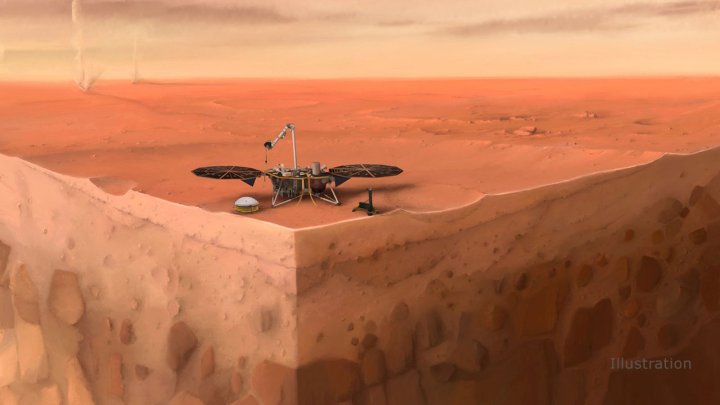
Poor little InSight lander. NASA’s explorer on Mars has spent nearly two years trying to bury its heat probe in the uncooperative Martian soil, which turned out to have a slightly different amount of friction than was expected. After trying fixes of all kinds, NASA has now announced it is giving up on getting the probe buried and operational.
But it’s not all bad news for InSight, as the lander’s other instruments are working well and collecting fascinating data on the Martian weather and the existence of marsquakes. The mission has recently been extended so the lander will continue operations for another two years.
The problems with the heat probe began in March 2019, when the self-digging part of the probe called the mole stopped its progress digging into the soil to place the probe beneath the surface. At first, it was thought that the mole may have hit a rock, but it later turned out that the problem was with the soil itself. The mole uses the friction of the soil to burrow into the ground, but the soil in this particular region has been compacted into a hard form called duracrust. That meant that whenever the mole tried to dig, it was pushed back out of the hole.
NASA engineers tried a variety of fixes including using the lander’s robotic arm to pin the mole in place and using the scoop on the end of the arm to push on the end of the mole to force it down into the soil. There was hope that these efforts might have worked in October last year, when the mole was successfully buried a few centimeters beneath the surface. But it hasn’t been able to make any progress since then, so the NASA team is now finally calling a halt to attempts to fix the problem.
“We’ve given it everything we’ve got, but Mars and our heroic mole remain incompatible,” said Tilman Spohn, principal investigator of InSight’s Heat Flow and Physical Properties Package (HP3) instrument of which the mole is a part, in a statement. “Fortunately, we’ve learned a lot that will benefit future missions that attempt to dig into the subsurface.”
Even though it has had problems, InSight has made remarkable discoveries including learning about marsquakes and collecting data that was processed into the sounds of Mars. As its mission continues, it will work as a weather station along with the two rovers Curiosity and Perseverance to help scientists understand more about the complex Martian weather system.
For now, those at NASA are taking the mole’s challenges in their stride. “We are so proud of our team who worked hard to get InSight’s mole deeper into the planet. It was amazing to see them troubleshoot from millions of miles away,” said Thomas Zurbuchen, NASA associate administrator for science in the statement.
“This is why we take risks at NASA — we have to push the limits of technology to learn what works and what doesn’t. In that sense, we’ve been successful: We’ve learned a lot that will benefit future missions to Mars and elsewhere, and we thank our German partners from DLR [German Aerospace Center] for providing this instrument and for their collaboration.”


